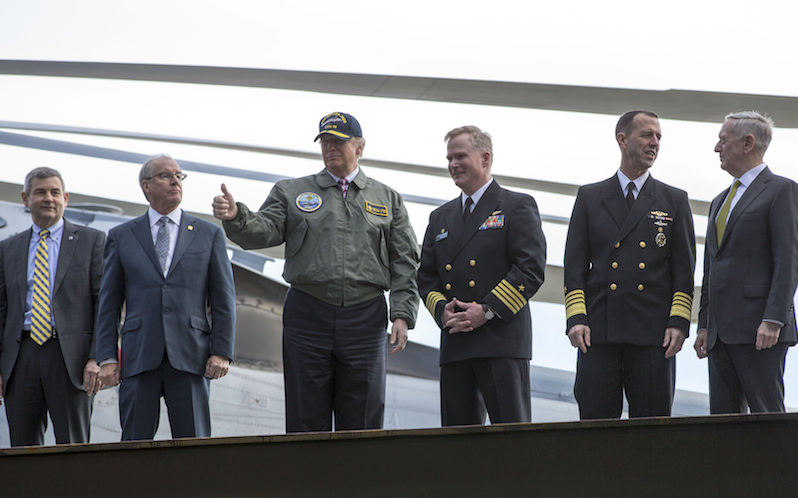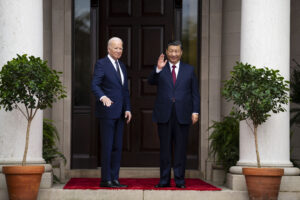Trump’s Military Nostalgia (or ‘Victory at Sea’ All Over Again)
The president's talk of rebuilding the U.S. military has been influenced deeply by the “Victory at Sea” documentary series and the war movies of Trump's youth. President Trump gives a thumbs-up to Navy personnel after a tour of the USS Gerald R. Ford in early March. (U.S. Navy / CC 2.0)
President Trump gives a thumbs-up to Navy personnel after a tour of the USS Gerald R. Ford in early March. (U.S. Navy / CC 2.0)
By Michael T. Klare / TomDispatch
If you are an American male of a certain age — Donald Trump’s age, to be exact — you are likely to have vivid memories of Victory at Sea, the Emmy award-winning NBC documentary series about the U.S. Navy in World War II that aired from October 1952 to May 1953. One of the first extended documentaries of its type, Victory at Sea traced the Navy’s triumphal journey from the humiliation of Pearl Harbor to the great victories at Midway and Leyte Gulf in the Pacific and finally to Japan’s surrender aboard the USS Missouri. Drawing on archival footage (all in black and white, of course) and featuring a majestic sound track composed by Richard Rogers of Broadway musical fame, the series enjoyed immense popularity. For many young people of that time, it was the most compelling, graphic imagery available about the epic war our fathers, uncles, and classmates’ dads had fought in.
Why do I mention this? Because I’m convinced that President Trump’s talk of rebuilding the U.S. military and “winning wars again” has been deeply influenced by the kind of iconography that was commonplace in Victory at Sea and the war movies of his youth. Consider his comments on February 27th, when announcing that he would request an extra $54 billion annually in additional military spending. “We have to start winning wars again,” he declared. “I have to say, when I was young, in high school and college, everybody used to say we never lost a war. We never lost a war, remember?”
Now, recall that when Trump was growing up, the United States was not winning wars — except on the TV screen and in Hollywood. In the early 1950s, when Victory at Sea was aired, America was being fought to a standstill in Korea and just beginning the long, slow descent into the Vietnam quagmire. But if, like Trump, you ignored what was happening in those places and managed to evade service in Vietnam, your image of war was largely shaped by the screen, where it was essentially true that “we never lost a war, remember?”
Trump similarly echoed themes from Victory at Sea on March 2nd in a speech aboard the USS Gerald R. Ford, America’s newest aircraft carrier. There, clearly relishing the opportunity to don a Navy bomber jacket — “They said, here, Mr. President, please take this home, he quipped happily. “I said, let me wear it” — he extolled the carrier fleet. “We are standing today,” he commented stirringly, “on 4.5 acres of combat power and sovereign U.S. territory, the likes of which there is nothing to compete.” Then, as part of a proposed massive build-up of the Navy, he called on the country to fund an enormously expensive 12th carrier on a planet on which no other country has more than two in service (and that country, Italy, is an ally).
The new president went on to discuss the role of U.S. aircraft carriers in World War II — yes, World War II! — a key turning point in the naval war against Japan. “You’ve all known about the Battle of Midway, where the sailors of the U.S. Navy fought with the bravery that will be remembered throughout the ages,” he noted. “Many brave Americans died that day, and, through their sacrifice, they turned the tide of the Pacific War. It was a tough tide, it was a big tide, it was a vicious tide, and they turned it.”
Again, Donald Trump (not exactly a well-read military historian) undoubtedly was recalling parts of Victory at Sea, or perhaps Hollywood’s 1976 version of the same, Midway (with its all-star cast of Charlton Heston, Henry Fonda, James Coburn, Glenn Ford, Robert Mitchum, and Cliff Robertson, among others). Both portrayed the famous battle in exactly this fashion: as the “turning of the tide” in the war against Japan. Yes, a speechwriter probably penned Trump’s lines, but they were spoken with such gusto that you could feel how heartfelt they were, how much they reflected his imagined “experience” of that war.
Trump’s attachment to these “memories” of America’s glory days at war helps explain his approach to military policy and defense funding. Typically, when proposing major increase in military spending, American presidents and their secretaries of defense have articulated grand strategic reasons for doing so — to contain Soviet expansionism, say, or accelerate the global war on terror. Trump’s White House doesn’t bother with such rationales.
Other than speeding up the war against ISIS in Syria and Iraq, a war launched two and a half years ago by President Obama and now apparently nearing its official completion date, President Trump’s only justification for throwing tens of billions of dollars more at the Pentagon is to overcome a supposed deterioration of U.S. military capabilities and to enable the Armed Forces to start “winning wars again.” Otherwise, the rationale seems to boil down to something like the following: let’s rebuild the Navy that defeated Japan in World War II so that we can win battles like Midway all over again.Trump’s Naval Fixation
During election 2016, Donald Trump’s only extended statement on defense policy came in a campaign speech delivered in Philadelphia on September 7th. He began with his promise that, if elected, “I will ask my generals to present to me a plan within 30 days to defeat and destroy ISIS.” (Those actual options, delivered by “his” generals more like 40 days into his term, seem to involve a modest strengthening of already existing Obama-era plans for crushing the Islamic State’s main strongholds in Iraq and Syria.) He also reiterated his campaign tropes that “immigration security is a vital part of our national security” and that NATO members must contribute more to the common defense. Then he began speaking in more concrete terms about his plans for repairing the U.S. military and his fixation on naval strength quickly came to the fore.
He first chastised the Obama administration for allowing the Navy to shrink to “the smallest it has been since 1915.” When Ronald Reagan left office, he continued, “our Navy had 592 ships. When Barack Obama took office, it had 285 ships. Today, the Navy has just 276 ships.”
Now, it’s possible to quibble about the importance of numbers versus quality, though most naval professionals would say that today’s fleet of advanced carriers, cruisers, and submarines (many of them nuclear-powered) packs a far greater punch than the larger but less capable Navy of the Reagan era. Still, the key point here is Trump’s obsession with size. Admittedly, he also spoke about the deterioration of the Army and the Air Force, but in that speech in Philadelphia he almost obsessively kept returning to the size of the Navy. Once elected, he promised, he would ask Congress to eliminate the defense sequester, an automatic cap on military spending, and pony up massive additional funds to rebuild the military, with the Navy getting preference in the allocation of those funds. “We will build a Navy of 350 surface ships and submarines,” he insisted. No strategic rationale was provided for that increase of 74 ships, save the intimidating effect they might have on potential adversaries. “We want to deter, avoid, and prevent conflict through our unquestioned military strength,” he asserted.
Trump returned to these themes in his remarks aboard the Gerald R. Ford. “Our Navy is now the smallest it’s been since, believe it or not, World War I,” he declared, again ignoring the fact that no naval officer in their right mind would trade today’s fleet for the 1918 one. “Don’t worry,” he continued, “it’s going to soon be the largest it’s been. Don’t worry. Think of that. Think of that.”
He then went on to extol the virtues of aircraft carriers in particular before plugging for number 12. “Our carriers are the centerpiece of American military might overseas,” he exclaimed. “This carrier and the new ships in the Ford class will expand the ability of our nation to carry out vital missions on the oceans to project American power in distant lands. Hopefully, it’s power we don’t have to use, but if we do, they’re in big, big trouble.”
Trump did not bother to say who “they” are because that’s not the point. Once America’s expanded carrier fleet is roaming the high seas, no foreign power would be foolhardy enough to challenge the United States in a conventional military duel, or so the Trumpian logic evidently goes. “There is no competition to this ship,” he said of the Gerald R. Ford, which, once launched, will be America’s 11th carrier. “It is a monument to American might that will provide the strength necessary to ensure peace.”
A Strategy for Victory — In Last-Century Wars
While touring the Ford, Trump insisted yet again that the goal of his multibillion-dollar defense buildup is to ensure the military’s success in future wars. “We will give our military the tools you need to prevent war and, if required, to fight war and only do one thing — you know what that is? Win! Win! We’re going to start winning again.”
But what kind of wars does he have in mind? Trump often speaks of his determination to defeat ISIS and other “radical Islamic terrorists” as his primary strategic objective. But it’s hard to see how an increase in the Navy’s fleet from 276 to 350 ships could possibly contribute to that endeavor. True, aircraft carriers are already being used to mount airstrikes on Islamic State positions in Iraq and Syria, but they are hardly essential for that purpose as the U.S. can use air bases in neighboring countries to conduct such strikes. Most other U.S. warships — cruisers, destroyers, submarines, and the like — have had little or no role to play in the counterterror operations of the last 15 years (except on rare occasions as temporary prisons for terror suspects).
Trump also aims to acquire more combat planes and to form additional Army combat brigades, but again such assets are unlikely to be crucial to the defeat of ISIS or other terrorist groups, though the new administration is now sending small numbers of conventional troops into Syria in addition to Special Operations forces. Given America’s painful experiences in Iraq and Afghanistan over the last decade and a half, there is visibly little appetite among the American public for the deployment of significant U.S. ground contingents in extended conflicts across the Greater Middle East or North Africa, and President Trump has made it clear that he will respect that preference. Accordingly, no matter how much he may decry President Obama’s methods, he appears inclined at the moment to merely bolster and accelerate his predecessor’s reliance on drone strikes, special ops forces, and proxy forces like Kurdish and Syrian rebel groups to combat ISIS and other terrorist organizations. No 12th aircraft carrier is needed to pursue such goals.Nor is the weaponry on Trump’s wish list, including advanced bombers and submarines, needed to ensure success, for instance, in that unique post-modern form of combat, the kind of hybrid warfare that’s been perfected by the Russians in Chechnya, Georgia, Ukraine, and now Syria. Combining conventional and unconventional modes of combat along with cyberwar, propaganda, and psychological warfare, hybrid operations have proven successful indeed in situations where the Russians have sought to achieve localized victories without precipitating intervention by the major powers. To counter such operations, the U.S. and its allies would have to become far more adept at detecting these unconventional modes of attack and rendering them harmless. No doubt some specialized new capabilities would be needed for this purpose, but it is unlikely that aircraft carriers and much of the rest of Trump’s wish list will have any significant role to play.
What about a war with a “rogue state” like North Korea or even Iran? These countries could, of course, pose a significant threat to their neighbors or even, to a lesser extent, to any American forces stationed in their vicinity. But in both cases, their conventional forces are mainly equipped with tanks and planes several generations older and less sophisticated than those in the U.S. arsenal and would not survive any encounter with the American military. The United States can also rely on allies with advanced weapons of their own to assist in any conflict with these countries.
There is, of course, the peril of nuclear proliferation. Fortunately, the 2015 nuclear accord that the Obama administration helped broker with Iran (plus Britain, France, Germany, Russia, China, and the European Union) eliminates any such threat from that country for the time being. Were President Trump to scrap the deal, as he suggested during the election campaign, this would only put U.S. allies and forces at greater risk. North Korea, of course, already possesses nuclear weapons and Trump will somehow have to find a strategy for mitigating that danger, but building more big ships and the like won’t be it.
What good, then, is our new president’s vast program to pump up the U.S. military with yet more ships, planes, and troops paid for, in part, by cuts to domestic programs that actually do provide Americans with genuine “security”? What wars will they “win”?
Their only real utility would be in a classic twentieth century conventional contest with a major power along the lines of the anti-German and anti-Japanese campaigns of World War II. In other words, as with so much else in his program to “make America great again,” the important word is again and the key frame of reference is the America of the 1950s. President Trump, like candidate Trump, clearly wants to plunge the country once again into a version of Victory at Sea, perhaps with the D-Day landing at Normandy thrown in.
If you happen to believe that either China or Russia, with its significantly more modest forces (each has a single aircraft carrier in operation), would be prepared to launch a new Pearl Harbor against the U.S. or its allies and then bring to bear what ships and planes are at its disposal (ignoring, of course, the world-ending nuclear arsenals all three countries possess), then count on the U.S. military, with an extra $54 billion in its pocket (or even without it), to have a definite combat advantage.
However, the leaderships of China and Russia would have to be stark raving mad to take such a course of action. Their militaries are instead developing “asymmetrical” modes of warfare intended to eliminate some U.S. advantages in conventional firepower in any future regional clash, including a heavy reliance on attack submarines, anti-ship missiles, and (in Russia’s case) tactical nuclear weapons. They know — who wouldn’t? — that they could never win another World War II-like encounter with the U.S. military and so aren’t even thinking about preparing for one. They know that victory in tomorrow’s wars, whatever that may mean, will require a whole new toolkit and playbook.
The one key figure who doesn’t seem to grasp this is, not surprisingly, Donald J. Trump. For him, Victory at Sea still seems to define the global battlespace, and the goal of any major power is still to possess sufficient air and sea power to vanquish a rival in a World War II-like clash of heavy metal. He reminds me of someone stuck in the age of the dreadnoughts, those giant battleships of the pre-World War I era, heading into World War II. More than anything else, though, I imagine him as an avid fan of the board game “Battleship,” a favorite pastime for teenagers in his schoolboy years. Sink enough enemy ships, the game taught you, and victory is yours. (“Win! Win! We’re going to start winning again.”)
The problem with all this, of course, is that it is exceedingly dangerous to impose fantasies of World War II on the realities of tomorrow’s battlefields. The pursuit of victory in fantasy wars via the building of elaborate weapons systems won’t just leave the U.S. unprepared for real threats like hybrid warfare and strain the country’s finances; it might also help trigger a heavy metal response, both excessive and inappropriate, as well as deeply dangerous in a nuclear age, to a minor challenge or even perceived challenge by a rival power — say, China in the South China Sea.
Victory at Sea remains a cinematic expression of our war-making past. If you really want to understand President Trump’s strategic mindset (such as it is), get your hands on a DVD of the series and watch it. But let’s pray it doesn’t turn out to provide a blueprint for a deeply militarized trip down memory lane to the 1950s and a world of future combat operations no one should want to imagine, no less plan for.
Michael T. Klare, a TomDispatch regular, is a professor of peace and world security studies at Hampshire College and the author, most recently, of The Race for What’s Left. A documentary movie version of his book Blood and Oil is available from the Media Education Foundation. Follow him on Twitter at @mklare1.
Follow TomDispatch on Twitter and join us on Facebook. Check out the newest Dispatch Book, John Feffer’s dystopian novel Splinterlands, as well as Nick Turse’s Next Time They’ll Come to Count the Dead, and Tom Engelhardt’s latest book, Shadow Government: Surveillance, Secret Wars, and a Global Security State in a Single-Superpower World.
Your support matters…Independent journalism is under threat and overshadowed by heavily funded mainstream media.
You can help level the playing field. Become a member.
Your tax-deductible contribution keeps us digging beneath the headlines to give you thought-provoking, investigative reporting and analysis that unearths what's really happening- without compromise.
Give today to support our courageous, independent journalists.






You need to be a supporter to comment.
There are currently no responses to this article.
Be the first to respond.